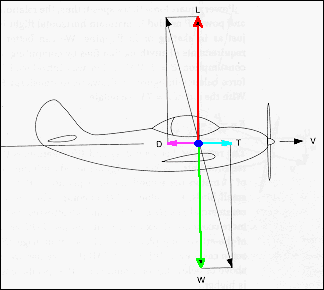|
Lift
The
diagram shows an aircraft in level flight with an airspeed, V. Four forces
are shown acting on the center of mass of the plane: the weight, W, the
lift, L, the propeller thrust, T, and the drag, D. In steady state, that
is no change in altitude or plane airspeed, the lift force is equal to
the weight, L = W,
and the drag force is equal to the thrust, D
= T.
The diagram also shows the resultant forces from the addition of lift and
drag, and the addition of thrust and weight. These resultant forces are
equal in magnitude and opposite in direction.
Power
is the product of a force and a speed. For this steady state situation,
the propulsion power required is: P
= TV = DV. Typically, drag increases as V2,
so that the power required to maintain steady state increases as V3.
The
specific energy consumption in this level flight condition is: E
= P/(WV) = T/W = D/L. For the lowest possible
specific energy consumption, drag should be as low as possible for a given
lift. |
|
|
|
|
|
|
|
|
|
|
